Diabetes Friendly Dinners
By Catherine Newman
.jpg) Mix-and-match dinner components for healthy, relaxing meals, featuring slow-roasted salmon, rotisserie chicken, zucchini spaghetti, and more!
Mix-and-match dinner components for healthy, relaxing meals, featuring slow-roasted salmon, rotisserie chicken, zucchini spaghetti, and more!
Dinner is a mystery to me. It is definitely my favorite meal to eat – but being in charge of getting it on the table can be kind of dispiriting. It just comes around and comes around, and even though you just made dinner last night, it is time to make more of it, to make it again and again, whether or not you are out of ideas and whether or not you have family members milling around like a school of hungry sharks.
.jpg) Dinner prep can be especially tricky if you’re trying to lower your overall carb intake since easy, comfortable favorites like spaghetti and meatballs, mac and cheese, or even breakfast for dinner have to be tinkered with. That’s why my recipes are meant to be the meal equivalent of practical wardrobe separates: you can make them as stand-alone recipes, or you can mix and match them into complete meals. They are generally low-carb, nutrient-dense, and also fairly straightforward and quite delicious. Plus, you can add whatever seasonings you like to make them even more interesting for yourself or the people you’re feeding – in other words, you can dress them up, dress them down, serve them with jeans, etc. Or that’s the hope.
Dinner prep can be especially tricky if you’re trying to lower your overall carb intake since easy, comfortable favorites like spaghetti and meatballs, mac and cheese, or even breakfast for dinner have to be tinkered with. That’s why my recipes are meant to be the meal equivalent of practical wardrobe separates: you can make them as stand-alone recipes, or you can mix and match them into complete meals. They are generally low-carb, nutrient-dense, and also fairly straightforward and quite delicious. Plus, you can add whatever seasonings you like to make them even more interesting for yourself or the people you’re feeding – in other words, you can dress them up, dress them down, serve them with jeans, etc. Or that’s the hope.
I want to say here, in the interest of full transparency, that lots of people at diaTribe, including our own Adam Brown and me, are increasingly convinced that lowering carbohydrate intake substantially helps stabilize blood sugars and makes people feel better. But then we’re not completely avoiding carbs, and we don’t want to assume that you are. (Although if you are, that’s great!) We are thinking of some of these foods – the quinoa, for example – as better options than the ones like bread or pasta that have lots of carbs that go in fast. But please feel free to tell us what you’re thinking, what you’re wanting to cook more or less of at home. Because we really want to know!
1 Store-Bought Rotisserie Chicken / 10 Meals
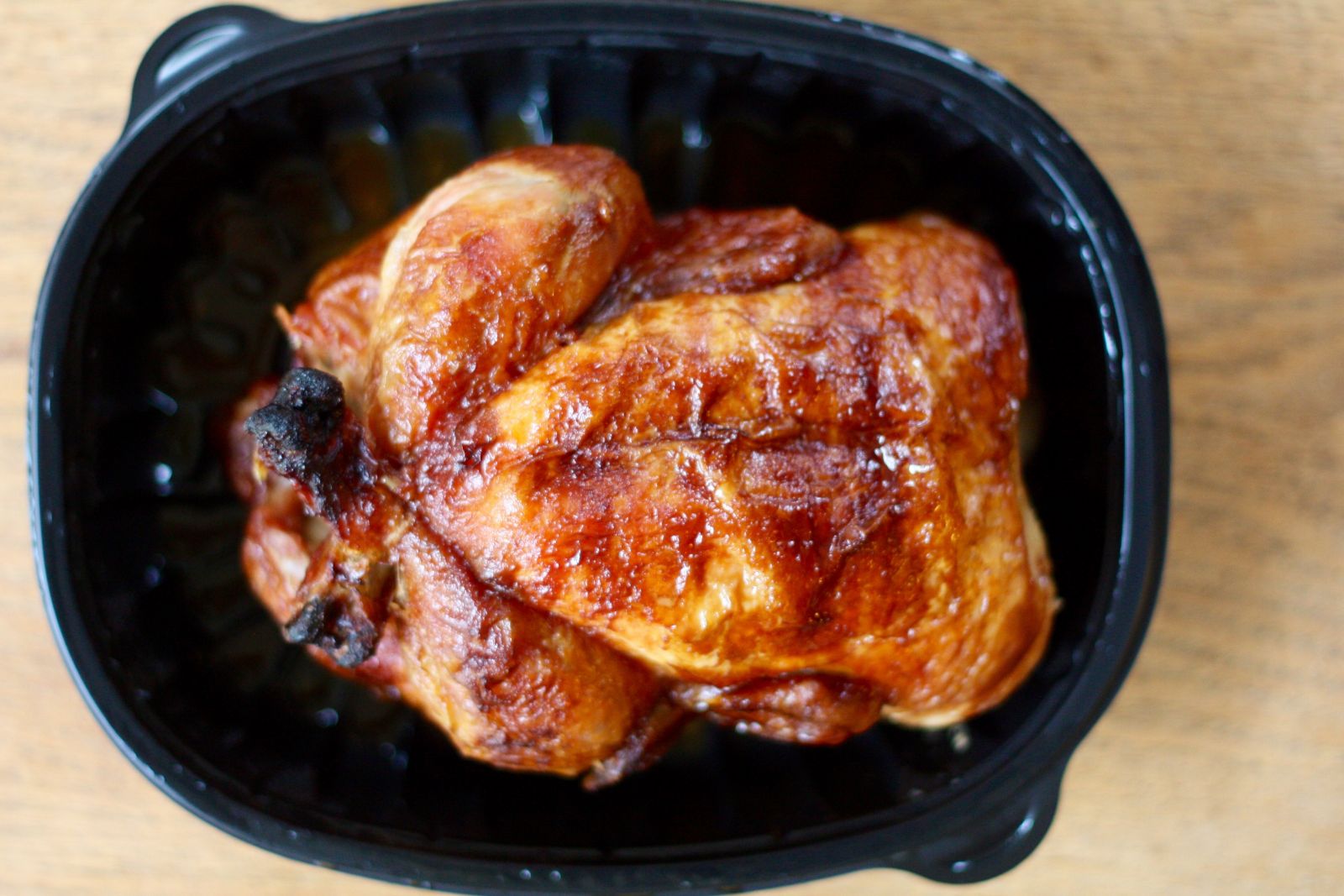 Okay, that’s a kind of inaccurate headline because you’re not really making 10 entire meals from a single chicken. It’s more that I’m giving you 10 different meal ideas for when you’ve bought a rotisserie chicken from the supermarket, but you don’t really want to have just the plain chicken (again). I love supermarket rotisserie chickens because they’re inexpensive and they’re tasty – and because they lend themselves to such a lovely range of meals, without the fuss of first prepping and cooking the chicken. (Plus, nobody will know that you peeled off and ate the entire bronzed chicken skin while you were cooking. Chef’s prerogative!)
Okay, that’s a kind of inaccurate headline because you’re not really making 10 entire meals from a single chicken. It’s more that I’m giving you 10 different meal ideas for when you’ve bought a rotisserie chicken from the supermarket, but you don’t really want to have just the plain chicken (again). I love supermarket rotisserie chickens because they’re inexpensive and they’re tasty – and because they lend themselves to such a lovely range of meals, without the fuss of first prepping and cooking the chicken. (Plus, nobody will know that you peeled off and ate the entire bronzed chicken skin while you were cooking. Chef’s prerogative!)
(Serving size and carb counts will depend on individual preparations, but I'm indicating what the source of carbs is below)
- Lettuce Wraps (The carrot will add up to 3 grams of carbs per serving)
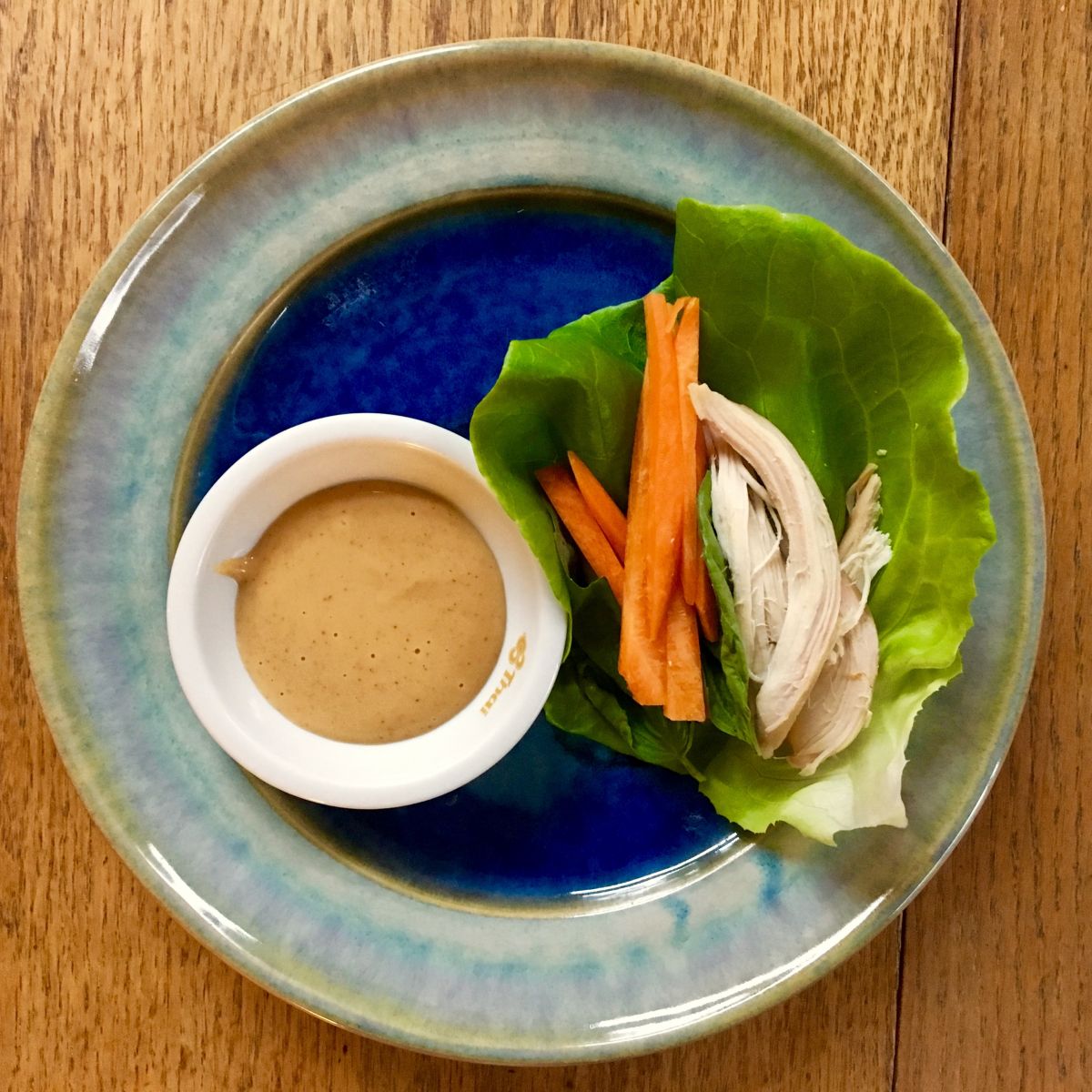
Butter or Boston lettuce leaves + shredded chicken + slivered carrots and/or cucumbers + basil and/or mint + a simple peanut dressing made by whisking together 2 tablespoons peanut butter (try to get the no-sugar ones), 1 tablespoon balsamic or rice vinegar, 2 tablespoons soy sauce, ½ teaspoon garlic powder, ¼ teaspoon cayenne, and enough warm water by the spoonful to make it creamy and drizzle-able
- Chicken Caesar (The chickpeas will add up to 15 grams of carbs per serving; feel free to omit them)
Cut-up Romaine lettuce + shredded chicken + grated parmesan + Caesar dressing + chickpea croutons (below). Adam’s Brown shared his Caesar dressing recipe, one he’s modified from The Keto Diet book: In a blender or food processor, whiz together 1 cup olive oil, ½ cup mayonnaise (use full-fat; look for Best Foods or Hellmann's; otherwise, check that there are 0 grams of sugar per serving), one small tin of anchovy fillets, 6 tablespoons lemon juice, 2-3 tablespoons Dijon mustard, 4 cloves of garlic (or 2 teaspoons garlic powder) and a grind of black pepper until creamy and smooth. This makes enough to dress 10 large plates of salad.
- Green Noodles with Chicken (The red pepper will add up to 3 grams of carbs, the zucchini noodles around 6 grams)
Sautéed zucchini noodles (see below) + pesto + shredded chicken + red bell pepper + toasted pine nuts + grated parmesan cheese
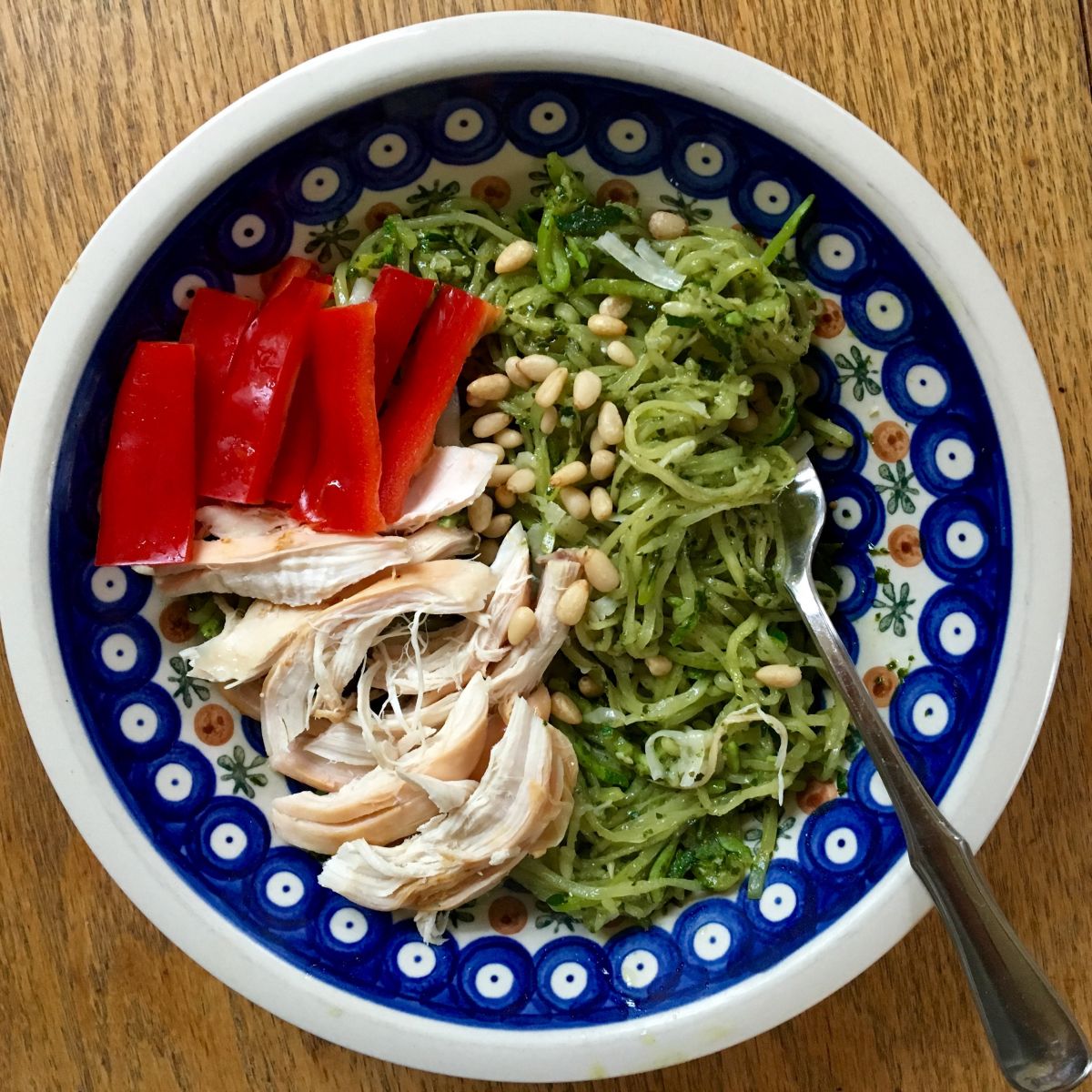
- Ginger-Miso Chicken Salad (The miso will add 2 grams of carbs, the almonds or peanuts up to 2 or 3 grams)
Cut-up Romaine lettuce + shredded chicken + sliced celery and/or cucumbers + toasted sliced almonds or roasted peanuts + miso-ginger dressing made by whisking together ¼ cup white miso + ¼ cup rice vinegar + 2 teaspoons finely minced ginger + 1 teaspoon soy sauce + 1/3 cup vegetable oil + 1 tablespoon warm water
- Chicken Burrito Bowl (The beans will add up to 10 grams of carbs, the avocado up to 3 or 4 grams)
Shredded chicken + black or pinto beans + shredded cheddar or Monterey Jack cheese + sour cream + salsa + diced avocado
- Buffalo Chicken Salad (The blue cheese dressing might add a gram or two of carbs)
Cut-up Romaine lettuce and/or mixed greens + shredded chicken + sliced celery + blue cheese dressing + a few shakes of Frank’s Red Hot or Louisiana hot sauce
- Mexican Chicken Soup (The tomato will add up to 5 grams of carbs, the avocado up to 3 or 4 grams)
Chicken broth + shredded chicken + canned tomatoes + sautéed onion and garlic + oregano and chili powder + lime juice + avocado + sour cream
- Cobb Salad (The tomato will add up to 4 grams of carbs, the avocado up to 3 or 4 grams)
Cut-up Romaine lettuce + shredded chicken + hard-boiled eggs + cooked bacon + diced avocado + chopped tomatoes + crumbled blue cheese + vinaigrette dressing
- Chicken Quesadizza (detailed recipe here) (The tortilla will add up to 3 grams of carbs, the broccoli 3 grams, the salsa 1 gram)
Low-carb tortilla + grated Monterey Jack cheese + salsa + shredded chicken + leftover roasted broccoli (below)
- Vietnamese Chicken Salad (The carrots will add up to 3 grams of carbs, the Sriracha or hot sauce up to 1 gram)
Slivered napa cabbage + shredded chicken + grated carrots + chopped mint and/or cilantro + lime vinaigrette made with 3 tablespoons lime juice + 3 tablespoons fish sauce + 3 tablespoons vegetable oil + 1 clove minced garlic + Sriracha or other hot sauce to taste
Zucchini Spaghetti
Makes: 2 servings
Total carbohydrates: 6 grams per serving
Hands-on time: 5-15 minutes (depending on whether you’re spiralizing yourself)
Total time: 5-15 minutes
So, yes, oodles of zoodles and all that – it’s true that spiralizing vegetables, i.e. slicing them into spaghetti-shaped strands, is kind of a food trend. But zucchini noodles are light and delicious, naturally low in carbohydrates, and naturally high in fiber and nutrients. Plus, if you give them the spaghetti treatment – sauce and cheese, a spoonful of pesto, or even simply a little pat of melting butter – you just might convince any squash-wary family members that they’re worth tasting.
A note on gadgets: I have a super-simple double-sided pencil-sharpener type spiralizer, and I find it quite easy to use. I would also recommend the SpiraLife Vegetable Spiralizer ($13.99), a hand-held no-bells-and-whistles model that I like because it's a) relatively inexpensive and b) entirely mechanical, which means you don't need to plug it in and it won't break.
However, you can invest in a more efficient gadget if you anticipate eating this a lot (Adam really likes this one) or you can even buy your veggies already-spiralized in some places if you want to pay a little more.
Ingredients
1 tablespoon olive oil
1 pound zucchini noodles (also called zoodles) or 1 pound zucchini (about 2 medium), spiralized
Salt
Instructions
-
Heat the oil in a wide skillet (ideally nonstick) over medium-high heat.
-
Add the zucchini and sauté, tossing gently with tongs as it cooks, until it is just barely tender. This will take around 3 minutes, and you should stop before you think it’s completely cooked because it will keep cooking and you don’t want it suddenly sitting in a flood of water. Likewise, don’t salt it until you’re done cooking it, since the salt also will pull water from it.
-
Salt and sauce as you like.
Perfect Slow-Roasted Salmon
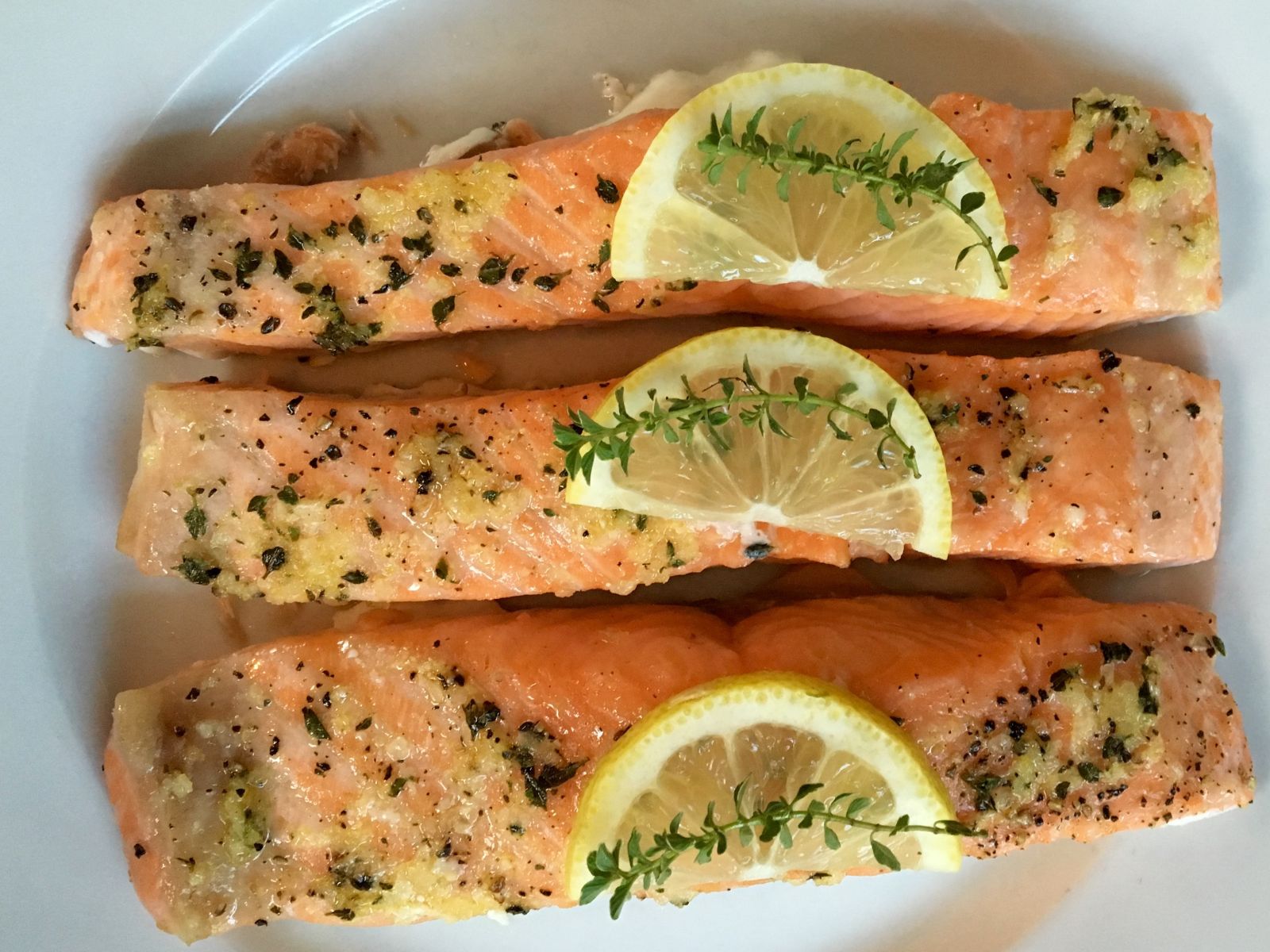 Makes: 4 servings
Makes: 4 servings
Total carbohydrates: less than 1 gram per serving
Hands-on time: 5 minutes
Total time: 20-30 minutes
This is my very favorite way to cook salmon (or cod or striped bass, for that matter): the fish ends up meltingly tender, with a velvety texture and a very fresh, mild flavor. Don’t expect it to brown (alas), and don’t expect it to look the way you might expect cooked fish to look, since it won’t turn pale pink and opaque. It’s perfect as a regular main course, or atop a salad for a leafier meal.
Ingredients
1 ½ tablespoons olive oil (divided use)
Grated zest of 1 lemon (quarter the lemon after zesting it)
1 clove garlic, smashed, peeled, and minced
1 teaspoon fresh thyme leaves, chopped, or another herb of your choosing (optional)
4 pieces of thick salmon fillet (ask for center-cut), 1- 1 ½ pounds total
Salt and freshly ground black pepper
Simple tartar sauce, below (optional)
Instructions
-
Heat the oven to 275° F. Cover a baking sheet with foil, then brush or rub it with the half tablespoon of olive oil.
-
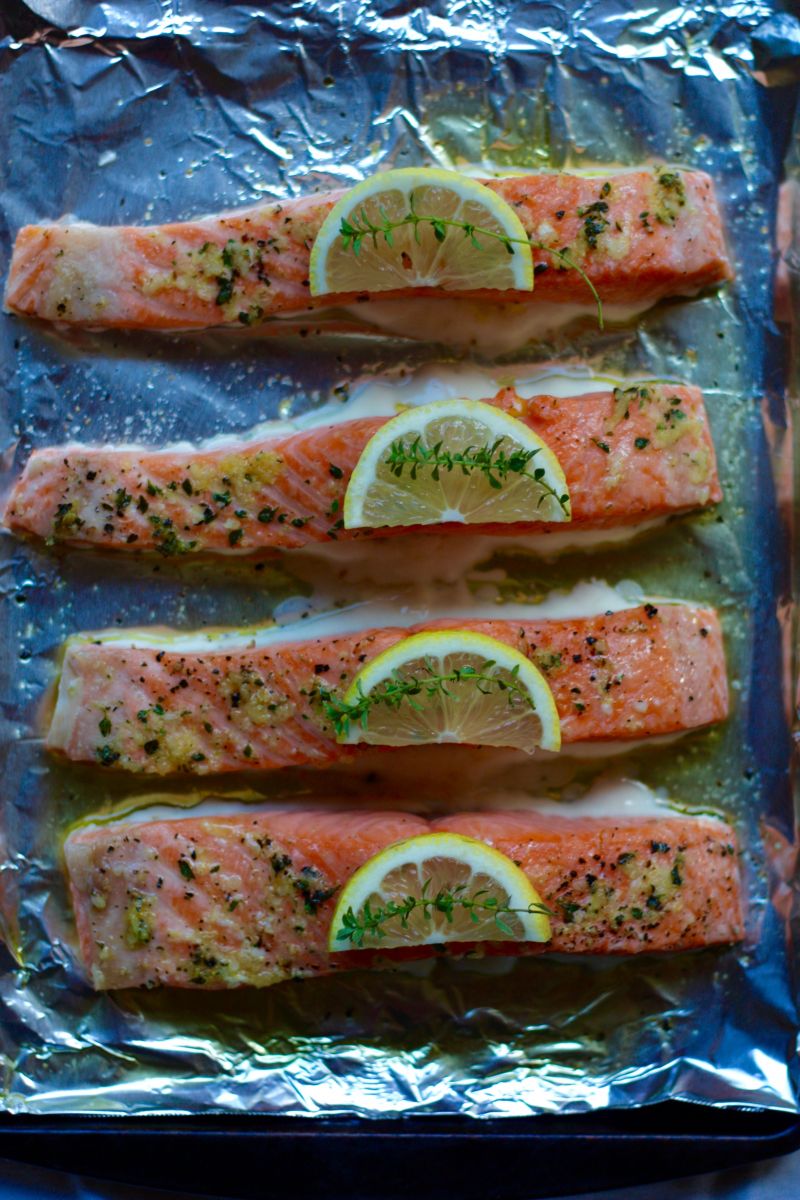 In a small bowl, stir together the lemon zest, garlic, and remaining tablespoon of oil.
In a small bowl, stir together the lemon zest, garlic, and remaining tablespoon of oil. -
Put the fish on the baking sheet, skin side-down. Sprinkle it with salt and pepper, then drizzle the lemon-garlic oil evenly over the fillets.
-
Roast for 15 to 25 minutes, until the flesh is just beginning to flake when you press a fork into it, and you can separate the fish from its skin. It might look different from the way you’re used to cooked fish looking – rosier and less opaque. That’s okay!
-
Serve with the lemon wedges, warm, at room temperature, or cold.
Simple Tartar Sauce
Whisk together ½ cup mayonnaise (use full-fat; look for Best Foods or Hellmann's; otherwise, check that there are 0 grams of sugar per serving), 1 tablespoon coarsely chopped capers, 1 tablespoon chopped parsley, 1 tablespoon lemon juice, and ½ teaspoon salt. Feel free to add finely chopped cornichons (mini sour pickles) or dill pickles, and/or chopped dill.
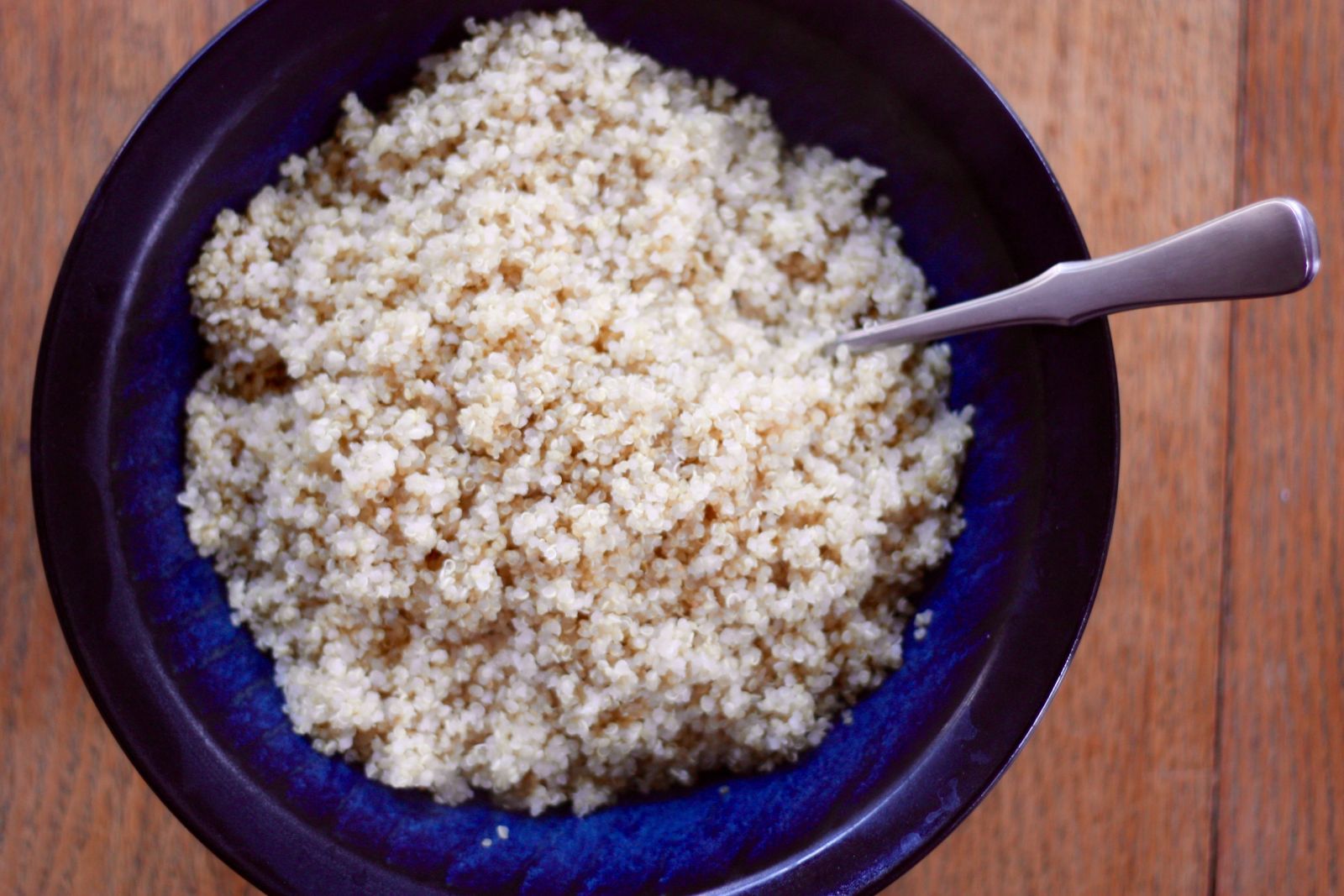 Quinoa
Quinoa
Makes: 6 servings
Total carbohydrates: 20 grams per serving
Hands-on time: 5 minutes
Total time: 20-30 minutes
Quinoa is a wonderful grain... or seed... or superfood of the Andes. Whatever it is, it’s somehow simultaneously tender and crunchy, and also nutty and delicious. Plus, it’s gluten-free, high in fiber, and super-high in protein. Try swapping it into any dish or meal that you’d typically use rice for, since it offers so much more nutritional value. And if you’re serving the quinoa as a plain side dish, try stir in the juice and grated zest of half a lemon. Yum. (But also, if you’re aiming for fewer carbs, try making something like cauliflower “rice” instead, which you can find in some frozen vegetable aisles – Trader Joe’s has great options.)
Ingredients
Salt
1 ½ cups quinoa
3 tablespoons butter or olive oil
Instructions
-
Bring a medium or large pot of water to a boil over high heat and salt it heavily. It should taste as salty as the sea, so we are talking a fair amount of salt.
-
Add the quinoa and stir, turn the heat down to medium-high and cook it for 10-15 minutes, uncovered, until it is just tender and the grains have spiraled open a bit. It will continue to cook as it steams, so don’t cook it until it’s soft at this point – just fish a little out with a fork to test.
-
Drain it really, really well in a fine sieve – I mean, really shake it around to get the water out – then put it back in the pot, stretch a doubled dish towel over the top of the pot, and put the lid back on. Leave it to steam for 5 to 10 minutes.
-
Stir in the butter or oil and serve.
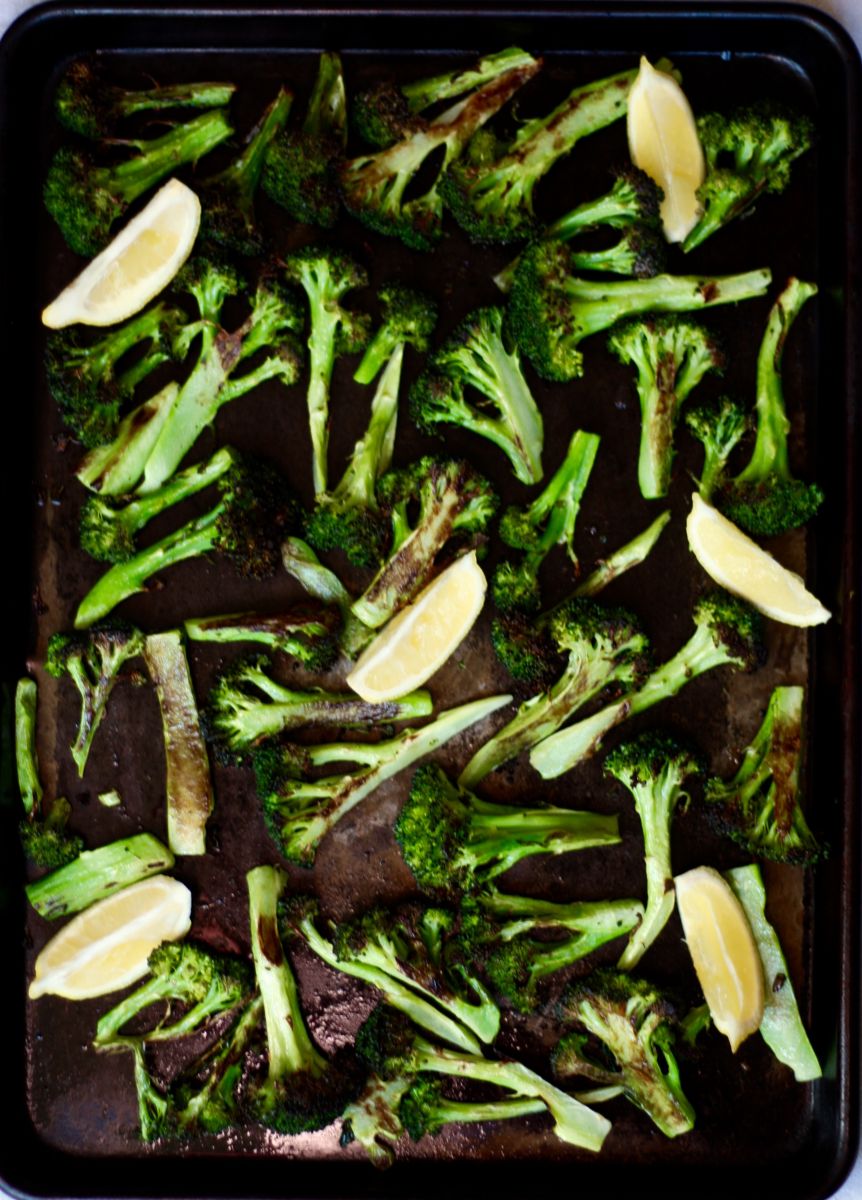 The Best Roasted Vegetables
The Best Roasted Vegetables
Makes: 4 servings
Total carbohydrates: around 10 grams per serving
Hands-on time: 15 minutes
Total time: 25-35 minutes
Ingredients
1 large head broccoli or cauliflower, or 1 ½ pounds Brussels sprouts
3 tablespoons extra-virgin olive oil
1 teaspoon kosher salt (or half as much table salt)
Optional: ½ teaspoon of sugar
Note: If you feel weird adding sugar to your vegetables, please feel free to leave it out. That seems completely reasonable to me, and the vegetables will still be totally good! However, because it helps the vegetables brown, because it only adds only a 1/2 gram of carbs per serving, and because this has, for years, been the best recipe I have for getting vast quantities of vegetables into the bodies of my children, I include it.
Lemon wedges, for serving
Instructions
-
Adjust an oven rack to the lowest position, place a large rimmed baking sheet on the rack, and heat the oven to 500 degrees.
-
If you’re using broccoli, peel the thick stems with a sharp paring knife as best as you’re able. Then cut the stem into long ½-inch-thick pieces and the rest into long, narrowish florets. If you’re using cauliflower, trim out the core with a sharp paring knife, then cut it up into florets, ideally cutting each in half so there’s a flat side. For Brussels sprouts, trim off the bottoms and any discolored leaves, then cut them in half.
-
Put the vegetables in a bowl, drizzle with the oil and toss well until evenly coated. Sprinkle with the salt and sugar, and toss to combine.
-
Remove the baking sheet from the oven, then dump on the veggies, spreading them in an even layer and placing flat sides down wherever possible.
-
Return the baking sheet to the oven and roast until the stalks are well browned and tender and the vegetables are lightly browned: about 10 minutes for broccoli; 15 minutes for cauliflower; 15-20 minutes for Brussels sprouts. Transfer to a serving dish and serve immediately with lemon wedges.
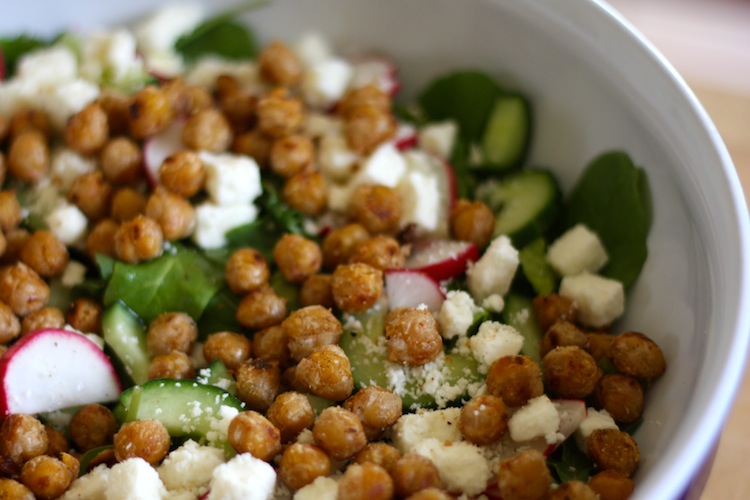 Chickpea Croutons
Chickpea Croutons
Makes: 1 cup (4 servings)
Total carbohydrates: 15 grams per serving
Hands-on time: 5 minutes
Total time: 25-20 minutes
I love these so much more than traditional croutons and they are better for you! They’ve got all the crunch, flavor, and saltiness you expect, but then they also add a ton of protein, fiber, and vitamins to your Caesar or green salad. Use a nonstick or well-seasoned pan, if you’ve got one.
Ingredients
2 tablespoons olive oil
1 (15-ounce) can chickpeas, drained and spread to dry on a double thickness of paper towels
Salt to taste (use plenty)
Garlic powder (optional)
Instructions
-
Heat the oil in a medium pan over medium heat until it is medium hot.
-
Add the chickpeas in a single layer, salt them liberally, and leave them for a few minutes, unpestered by you and your spatula, so they can start to turn a bit golden on the bottom. Now start flipping and turning them every so often, shaking the pan around, until the chickpeas are as crisp and brown as they could be without burning. This will take 10-15 minutes.
-
Add a sprinkle of garlic powder, if you’re using it, then taste for salt and remove the chickpeas to a paper-towel-lined dish to cool a bit before their introduction to the salad.







